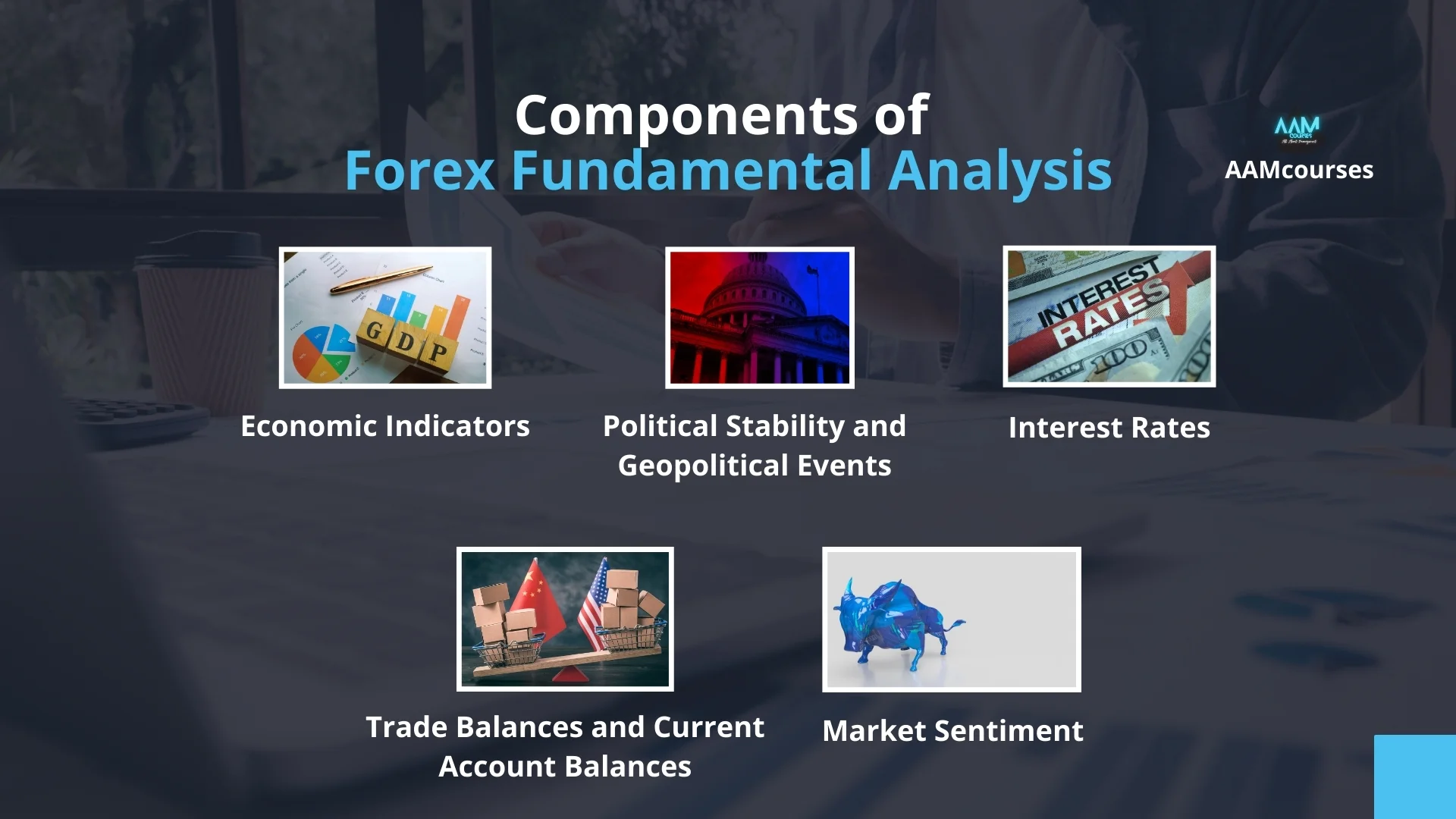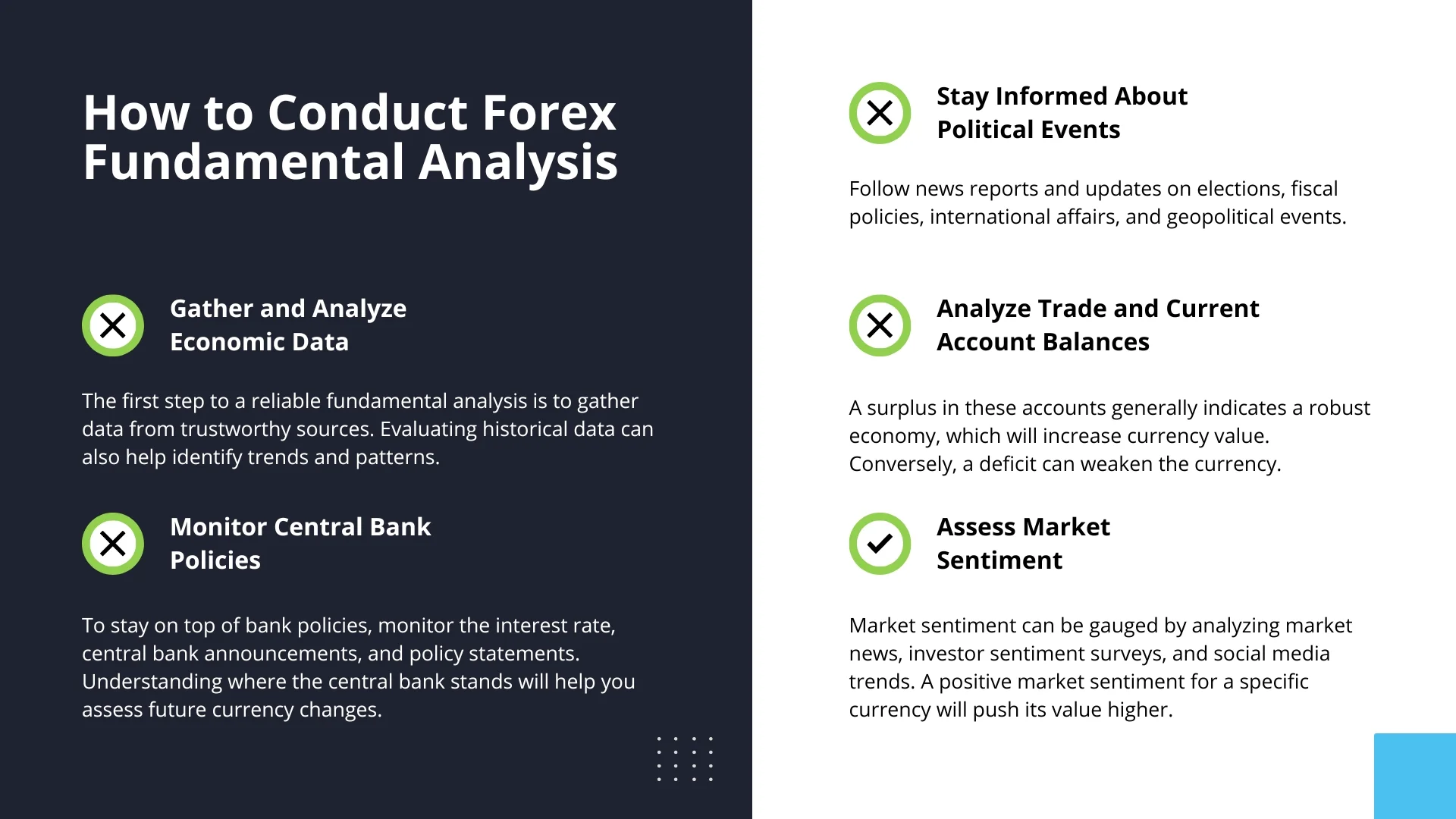Forex trading, popularly known as foreign exchange trading or currency trading, is when people buy and sell the currencies of the global market to make a profit. While trading in such a delicate environment, it is important to select the right analysis tool for successful trading; that’s where fundamental analysis comes in.
In forex fundamental analysis, we analyze a country’s economic and political indicators to determine whether the price of its currency is going to rise or fall. In this post, we will study the details of the forex fundamental analysis, its importance, and how to effectively apply it in your trading strategy.
ALSO READ ABOUT 5 Things to Know Before The Market Opens – Trader’s Secret
What is Forex Fundamental Analysis?

Fundamental analysis in forex is the method of evaluating the intrinsic value of a country’s currency by examining related factors such as economic, political, financial, quantitative, and qualitative factors.
Technical analysis focuses on factors like price charts and patterns, which can be useful in the short term. Conversely, fundamental analysis assumes the broader picture and analyzes factors that show the long-term picture.
Why is Fundamental Analysis Important?
By providing valuable insights into the underlying reasons behind currency price movements, fundamental analysis empowers forex traders to make informed and confident trading decisions.
By analyzing economic indicators, interest rates, geopolitical events, and other factors, traders become more equipped to make better decisions. Forex Fundamental analysis enables traders to comprehend the broader economic context of the market they trade in.
Key Components of Forex Fundamental Analysis

1. Economic Indicators
Economic indicators, such as GDP, inflation, sales, and unemployment rates, are statistics provided by government or private organizations. They offer a comprehensive understanding of a country’s economic performance, making traders feel knowledgeable and well-informed.
- Gross Domestic Product (GDP): GDP calculates the total number of goods and services produced in a country. A growing GDP indicates towards a rising economy and, ultimately, a growing country and its currency.
- Inflation Rates: Inflation measures the rate at which the prices of goods and services in a country fluctuate. A rising inflation rate leads to a lower Purchasing Power Parity for the country. On the other hand, lower inflation means more purchasing power for people and a higher value of the currency for the country.
- Unemployment Rates: A country’s unemployment rate indicates the percentage of the workforce actively looking for employment opportunities. A lower unemployment rate means a healthy economy and a stronger currency.
- Retail Sales: Sales numbers represent the number of products and services sold. A rising sales number indicates better economic growth and a rising currency value.
2. Interest Rates
Interest rates set by the central government are one of the key influencing factors in forex fundamental analysis. Higher interest rates attract more foreign investors. Such interest from foreign investors also increases the demand for the currency, ultimately raising the currency’s value.
On the other hand, a lower interest rate will reduce the demand and drive the currency even lower. Many central banks use interest rates to control inflation and stabilize their economy.
3. Political Stability and Geopolitical Events
Political stability and geopolitical events can significantly impact a country’s currency value and are a crucial part of forex fundamental analysis. Unstable politics, elections, changes in government policies, and international conflicts can increase fluctuation in the forex market. As a trader, it is your duty to stay up-to-date on these information about the currency you’re interested in.
4. Trade Balances and Current Account Balances
A country’s trade balance (the difference between exports and imports) and current account balance (the difference between a country’s savings and investment) are essential components of fundamental analysis.
A surplus trade balance indicates a higher rate of exports than imports, which can boost the currency. On the other hand, a poor trade balance will reduce the currency’s value.
5. Market Sentiment
Market sentiment represents the investors’ and traders’ attitudes towards the current market, in this case, a specific currency. It can be influenced by economic data, news events, and market speculation. If investors and traders have a positive outlook, it will push the currency value higher; conversely, a negative outlook will result in declining currency value.
How to Conduct Forex Fundamental Analysis

Step 1: Gather and Analyze Economic Data
The first step to a reliable forex fundamental analysis is to gather data from trustworthy sources. This includes government websites, central banks, and financial news providers.
Pay attention to the release dates of economic indicators and central bank announcements. Evaluating historical data can also help identify trends and patterns.
Step 2: Monitor Central Bank Policies
A country’s monetary policies play a leading role in influencing its currency. To stay on top of these policies, monitor the interest rate, central bank announcements, and policy statements. Understanding where the central bank stands will help you assess future currency changes.
Step 3: Stay Informed About Political Events
Political events and developments can have a huge impact on currency valuation. Follow news reports and updates on elections, fiscal policies, international affairs, and geopolitical events. Understanding the political situation can help you anticipate potential market volatility.
Step 4: Analyze Trade and Current Account Balances
Analyze a country’s trade and current account balances to estimate its economic health. A surplus in these accounts generally indicates a robust economy, which will increase currency value. Conversely, a deficit can weaken the currency.
Step 5: Assess Market Sentiment
Market sentiment can be gauged by analyzing market news, investor sentiment surveys, and social media trends. A positive market sentiment for a specific currency will push its value higher. On the other hand, a negative market sentiment towards that currency will result in declining currency value.
ALSO READ ABOUT What are Derivatives in Stock Market? 4 types of derivatives – Best Trader’s Secret
FAQs
How do you fundamentally Analyze forex?
To fundamentally analyze forex, examine key economic indicators, central bank policies, political stability, trade balances, and market sentiment to determine which underlying factors influence currency values. This approach helps predict long-term currency movements based on a country’s overall economic health and geopolitical situation.
What is the best fundamental indicator for forex?
The best fundamental indicator for forex is the interest rate set by a country’s central bank, as it directly influences currency value by affecting investment flows, inflation, and overall economic stability.
How Do Forex Traders Make Money?
Forex traders make money by buying and selling currency pairs, profiting from the fluctuations in exchange rates between two currencies. Traders tend to buy low and sell high to capitalize on the cost differences.
What Is Fundamental Analysis in Forex Trading?
Fundamental analysis in forex is the method of evaluating the intrinsic value of a country’s currency by examining related factors such as economic, political, financial, quantitative, and qualitative factors to predict future currency movements.
How to Conduct Forex Fundamental Analysis?
To conduct forex fundamental analysis, gather and analyze economic data such as GDP, inflation, and unemployment rates, monitor central bank policies and interest rate decisions, stay informed about political events, and assess trade and current account balances to understand the factors affecting a currency’s value.
Final Statement
Forex fundamental analysis is an amazing method for forex traders to understand the underlying factors that affect currency prices.
By analyzing economic indicators, central bank policies, political events, trade balances, and market sentiment, traders can become more equipped to make more accurate decisions and anticipate market trends.
I hope this post on Forex Fundamental Analysis is informative. Use the comment section to express your doubts and queries.

